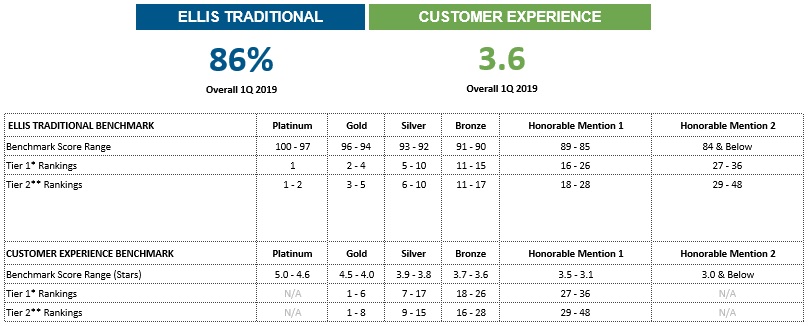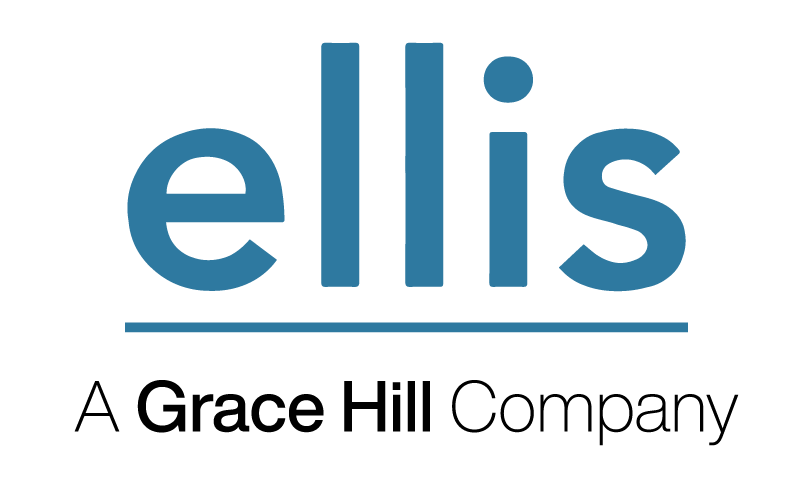
First Quarter 2019 Benchmark Results for Mystery Shops and Resident Surveys Executive Summary
Since 1984, our goal has been to help you achieve yours. Ellis, Partners in Management Solutions is proud to offer a turn-key integrated customer experience program, backed by our outstanding customer service, cutting-edge technology, and longstanding ethical business practices. Our mystery shops, resident surveys, live training, and e-learning partner (Edge2Learn) are resources that can also be used independently to address specific needs or jointly for ongoing employee performance optimization. We believe that the more you know about your customers and what they have to say about your employees, product, and services the better you can respond to and anticipate their needs. As a result, the more successful you will be at cultivating loyal customers who invest more, stay longer, and refer friends and family.
Our 2019 training theme is “Transitioning from Learn to Work to Work to Learn“. To keep pace with the everchanging workplace, employees must fine-tune their existing skills and use tools and resources to develop new ones. These are non-negotiable building blocks, and the more they try their hands on different things, the more their chance of success escalates. Yet, it all begins with a corporate culture that is willing to lead, embrace, and celebrate a work to learn environment.
ELLIS’ FIRST QUARTER 2019 BENCHMARK: OVERALL RESULTS
Mystery Shops
Ellis benchmarks mystery shop performance on the 10 key Benchmark questions and the Customer Experience. Companies can qualify for platinum, gold, silver, or bronze level based on their company’s overall Benchmark score for the quarter.
In 2018, the overall average Ellis Traditional Multifamily Industry Benchmark score across Ellis’ entire database of eligible shops was 86%, representing 45,560 shops, remaining steady at 86% for First Quarter 2019, representing 11,906 shops. In 2018, the overall average Ellis Customer Experience Benchmark score was 3.6 and is unchanged at 3.6 for First Quarter 2019.

* Tier 1 = 70 or more shops
** Tier 2 = 30-69 shops
(Note: Grid reflects the rankings of the companies that fell within that placement category for the respective Tier for the current quarter)
CONGRATULATIONS TO ELLIS BENCHMARK TOP PERFORMING MYSTERY SHOPPING COMPANIES: FIRST QUARTER 2019
Ellis Traditional Benchmark Platinum Level Achievers
Tier 1
(70 or more completed shops)
• Western National Property Management Ellis Traditional Benchmark
Ellis Traditional Benchmark Platinum Level Achievers
Tier 2
(30 – 69 completed shops)
• Legacy Partners Residential, Inc.
• Windsor Property Management Co / GID
Ellis Customer Experience Benchmark Gold Level Achievers **
Tier 1
• AMLI Residential
• Cortland Partners
• CWS Apartment Homes, LLC
• Matrix Residential
• Mill Creek Residential Trust
• Wood Partners
Ellis Customer Experience Benchmark Gold Level Achievers **
Tier 2
• Holland Residential
• IMT Residential
• Irvine Company Apartment Communities
• Legacy Partners Residential, Inc.
• Preferred Residential Management
• Richman Property Services, Inc.
• Windsor Property Management Co / GID
• ZRS Management, LLC
*Companies are listed in alphabetical order
**Customer Experience Benchmark gold level achievers are recognized as there were no platinum achievers for this period
Resident Surveys
The Ellis Loyalty Benchmark identifies and recognizes the customer experience performance of companies subscribed to the Ellis Resident Surveys Program. It evaluates performance on 5 key touchpoints of the prospect and resident journey. The percentage of surveys responded to by the onsite team and the average number of days it took for the team to respond are also measured because these two factors impact the customer relationship and overall loyalty. Utilizing customer loyalty as a metric allows customer-centric companies the ability to forecast three specific customer behaviors: likelihood to convert/renew, willingness to pay more, and likelihood to recommend.
Ellis’ customer loyalty score is based on a scale of 0%-100% (see chart below):

The overall average Ellis Loyalty Benchmark score in 2018 was 75%, compared to 78% for First Quarter 2019. In 2018, the onsite response rate averaged 87%; First Quarter 2019 increased slightly to 89%. Teams took an average of 4.9 days to respond in First Quarter 2019 versus an average of 5.7 days in 2018.

CONGRATULATIONS TO ELLIS BENCHMARK TOP PERFORMING RESIDENT SURVEYS COMPANIES FIRST QUARTER 2019
Ellis Best in Class Achievers
Tier 1 (1,600 or more units)
• Affinity Property Management
• Block Multifamily Group, LLC
• Capstone Real Estate-OPS
• CWS Apartment Homes, LLC
• Fore Property Company
• Guardian Management, LLC
• Landmark Communities
• Lincoln Property Company
• LMC, a Lennar Company
• Madison Apartment Group, LP
• Manco Abbott
• MG Properties Group
• Olympus Property
• R & V Management Corporation
• Simpson Property Group
• Steadfast Management
• The Tomanek Group
• TriBridge Residential
• Woodmont Properties
• Woodward Management Partners
• Zaremba Management Company
Ellis Best in Class Achievers
Tier 2 (1,599 or fewer units)
• Capital Properties
• Carlisle Property Management (CPM)
• CLMS Management
• Dolben
• Evolve Management Group, LLC
• GDC Properties, Inc.
• Ghertner & Company
• HRI Properties
• Mack Urban Communities
• Provence Real Estate, LLC
• ResideBPG
• Rock Companies
• Russo Development
• Samuels & Associates
• Stockbridge Capital Group
• Sunrise Management & Consulting
*Companies are listed in alphabetical order
ELLIS’ FIRST QUARTER 2019 BENCHMARK: QUESTION/TOUCHPOINT RESULTS
Mystery Shops
How did we do?
The charts below reflect the average score of Ellis’ entire database of eligible shops for each of the 10 key benchmark questions and the Customer Experience by category, as well as the combined overall Benchmark scores for First Quarter 2019.

Resident Surveys
How did we do?
The chart below reflects the average scores across all Ellis Resident Survey companies for each survey touch point for First Quarter 2019, as well as the combined overall loyalty score and average accountability performance results.


TRANSITIONING FROM LEARN TO WORK TO WORK TO LEARN: CULTURE
Is it time to transition from learn to work to work to learn? For years, our training programs and even education as a whole have been designed around the principle of learn to work. Leasing professionals learn their role, they gain more experience, all to be applied to the next known step in their career ladder. Then they start the process all over again. But what happens when those steps are not known? When experience does not matter? When the career ladder desire is replaced with an unknown career journey?
To thrive in a future that is unfolding faster than we can imagine it, employees must become adept at learning continuously. They must scan their industry for signals of change and be able to react instantaneously. Additionally, they need to be able to connect the dots between people and ideas, where others see no possible link. Psychologist Howard Gardner calls this ability searchlight intelligence. An informed perspective is more important than ever in order to anticipate what comes next and to succeed in the future. According to Deloitte’s Global Human Capital Trends research, problem-solving, cognitive abilities, and social skills will be the top three most in demand capabilities for the future of work.
The work to learn culture lines up beautifully with the Millennial generation, who are expected to make up 50 percent of the workforce by next year and 75 percent by 2025. Interestingly, according to a report released by ManpowerGroup, instead of climbing corporate ladders, Millennials are focused on learning technical and personal skills to ensure long-term career security as they seek to build a ‘career for me’ instead. As technological innovation changes the way work gets done, career success will increasingly be determined by a person’s learnability – the desire and ability to quickly grow and adapt one’s skill set to remain marketable throughout their working life regardless of career choice. As leaders, we must be able to recognize, nurture, and reward learnability. The future of work is learning. Encouraging imagination, conversations, and self-discovery will always pay high dividends.
So, where does the transition to a work to learn environment begin? First, we must understand the difference between a learn to work and a work to learn culture. Second, take time to gather the wavemakers. Third, equip employees with the tools they will need to advance the work to learn culture: imagination, conversations, and self-discovery. Finally, empower them to manage and grow their own careers by developing their problem-solving, cognitive abilities, and social skills.
While a work to learn culture will look different at every office, it will feel the same. Celebrate the culture daily, refresh it often, and move quickly when change is necessary.
Transitioning the Culture: Learn to Work vs. Work to Learn
What might be considered a subtle change in word placement can have a significant impact on a company’s culture. When you transition from a learning to work culture to a working to learn culture, the last word stated is the goal. One approach is to work towards mastering a job and the other is to learn towards any job or career; they are very different concepts. We have come to a point where we can no longer leave all learning to training departments. While the core courses should be left to the training experts, employees should take control of their own learning. Learning is their work, and if learning is everywhere, it ought to be where the work is getting done and not saved for the training room. In a work to learn culture, employees take on the responsibility of understanding rising situations, seeing patterns, and co-solving problems in the leasing office on a daily basis. There is no time to pause, contact the training department, and then develop something to address learning needs, because the problem will have morphed by then. In the work to learn culture, the transmission of ideas can be instantaneous, and new practices evolve as they are engaged, probed and developed. Such a culture can only take place in a work to learn environment where learning is a part of work, not separate from it. Learning is integrated into an employee’s daily activities, and training no longer seems like an extraneous task but a relevant part of what they do every day. Essentially, learning becomes the end result that never ends.
1. Gather the Wavemakers
A true work to learn organization is established at the top with a culture that embraces the belief that people, ideas, and technology move quickly, and teams should as well. To begin the transition, leaders must make a deliberate effort to shift expectations for employees and to shape the cultural forces which give voice to the culture. Developing a company culture is an art, and like any art it takes practice and unwavering determination to master. This mastery begins at the top. The challenge for some companies is that it is unclear where the top really begins. Who has the most influence in the company? Who are your wavemakers? Big waves generated at the top resonate throughout the ranks, and the more people are affected, the more the culture shifts. I believe that company culture is what you allow it to be, and what you allow you condone. Too often, the mission statement and values of a company are not reflected in the employee activity – all print and no action. In fact, when asked, many employees cannot recite their own company mission statement or values. While a culture is shaped at the top, it is formed at the bottom. But the shape the changes take is not always predictable. In a work to learn culture, employee empowerment is vital, yet it does not always exist. A 2018 Global Human Capital Trends research study revealed that 59 percent of respondents rated their organizations as not effective or only somewhat effective at empowering people to manage their own careers. A transition to a work to learn culture cannot be a subtle one. The waves must be big!
“My own definition of leadership is this: The capacity and the will to rally men and women to a common purpose and the character which inspires confidence.” -General Bernard Law Montgomery
2. Advance the Work to Learn Culture with Imagination, Conversations and Self-Discovery
Imagination: Imagination was a big buzzword when we were kids. However, since entering the workplace, it has almost vanished from our vocabulary. That is unfortunate because our imaginations can help us solve challenging business problems, innovate, and uncover new possibilities. The day-to-day repetitive tasks can create for a very dull and unproductive work environment, so as you advance the work to learn culture, encourage employees to harness their imagination and transition out of the mundane workday. Letting the mind wander can trigger creative thinking, launch new ideas, and uncover untapped potential in employees. Unleashing the imagination will also add some fun back into the day and get your employees bursting with new ideas.
- Brainstorming Journal Downtime– Provide each employee with a 30-minute downtime and a work journal. Their only objective is to write down ideas and thoughts about the business, customers, challenges, opportunities, ideas, wish lists, etc. It does not even need to make sense. They just need to write something down. Did you know that Southwest Airlines started with a cocktail napkin?
- Creativity– In his book Imagine: How Creativity Works, Jonah Lehrer discovers that creativity can be honed. He writes that most breakthroughs are simply the result of connecting two or more already known concepts in a new way. He encourages us to imagine that the ideas are already floating around in our brain; our job is simply to give them a relaxed and comfortable environment to come together. What about creating a Lego station for your employees? Sean McCusker is an associate professor of education at Northumbria University and a Lego-accredited ‘serious play facilitator’. He researches different ways people can learn and communicate in various settings. He writes, “I get people to build models symbolizing their ideas. The builder then has to explain these, so the ideas are shared and made explicit – this makes it easier to explore the relationships between different people’s ideas, to see how they work together, and when you reach agreement, everyone has contributed, because it’s based on everyone’s model.” Watch his video!
- Three Creativity Challenges from IDEO’s Leaders– Check this out!
Conversations: Steve Jobs believed that the most important meetings and conversations happened by chance and outside of the boardroom. In the Pixar offices, Steve Jobs famously redesigned the offices, which originally housed computer scientists, animators, executives and editors in three different buildings. He recognized that separating these groups, each with its own culture and approach to problem-solving, discouraged them from sharing ideas and solutions. So, he intentionally designed meeting rooms and mailboxes which were positioned in the building’s main atrium near the cafeteria, coffee bar and bathrooms to increase the chance of random interactions between employees who otherwise might not ever meet each other.
- Function In We Rather Than Me Mode. With all of the positive potential outcomes, setting up productive team conversations is easier said than done. Time constraints and differing personalities leave leasing teams functioning in their own me mode. Dig deep and carve out conversation time for your employees. While a face-to-face interaction is best, there are collaborative tools such as Slack which has become a staple across many businesses. Slack is a hub for conversations, ideas, etc. When employees’ ideas spawn in their head during the day or at night, they can jump on Slack and share it with their team.
- Lunch and Learn Program. This one might seem like the impossible with most offices being made up of very small staffs, but where there is a will there is a way. This could definitely work in a corporate office setting and where there are multiple communities within a close proximity. While individuals value their lunch breaks, a casual brainstorming conversation that occasionally taps into this period can be interesting and invigorating for everyone involved. This idea could take on many different looks and be a venue for a variety of productive conversations too. Get something started!
Self-Discovery: People spend a big chunk of their life at work. One estimate shows us that 35 percent of a person’s total waking hours over a 50-year working life will be at the office. If they are going to discover anything about themselves and their career potential, it will probably be at work. Developing a self-portrait can help an employee explore their potential, and it should be encouraged. In the old learn to work culture, we tend to not explore the potential of employees but instead groom them for the next step. In the work to learn culture, self-discovery can be a huge benefit for the employee and the employer. It can take employees into unknown and unforeseen territory, which is the key to discovery! Self-reflection and asking good questions play a big part in the self-discovery phase.
- Values: What is important to them? What do they want to achieve at work?
- Interests: What do they enjoy doing? What are their talents outside of work?
- Personality: What makes them unique? What motivates them? What are their needs?
- Skills: What are they good at? Where do they show potential? Are they a teacher? A writer? A great communicator?
In his 2004 article, “Systems Thinkers in Action: Moving beyond the standards plateau”, the author Michael Fullen sums up the importance of self-discovery well: “A learning organization is a place where people are continually discovering how they create their reality and how they can change it.”
3. Develop Problem-Solving, Cognitive Abilities, and Social Skills
It bears repeating that in Deloitte’s Global Human Capital Trends research, problem-solving, cognitive abilities, and social skills will be the top three most in demand capabilities for the future of work. These are the three skills that should be nurtured in the work to learn culture. A focus in these areas will appeal to the desires of a generation who is not as interested in climbing the corporate ladder as they are at ensuring long-term career security and building their ‘career for me’. They are looking for a company who will offer a work to learn culture and empower them to reach their potential, rather than simply teach them rote tasks. Millennials are looking for experiences, not jobs. An entrepreneurial, work to learn, culture is what they crave. They want to disrupt the status quo, learn constantly, and leave their fingerprints on the world. Remember, they will represent nearly fifty percent of the 2020 workforce.
Will your company speak to their desires? Are you ready, willing, and able to transition your culture from one of learn to work to work to learn? Ready. Set. Go!
We thank you for your ongoing participation and feedback, which help make this report informative, fresh, and a reliable resource. We hope you will find Ellis Partners in Management Solutions to be not only the finest source for mystery shopping and resident surveys but also a training resource (including our partner Edge2Learn) for your organization. Additional support and information can be found on our website.
April 30, 2019
Prepared by Joanna Ellis, Chief Executive Officer and Francis Chow, Chief Strategic Officer
Footnotes: 1 See Ellis website for Benchmark eligibility, tier level, and recognition requirements for mystery shops and resident surveys.

